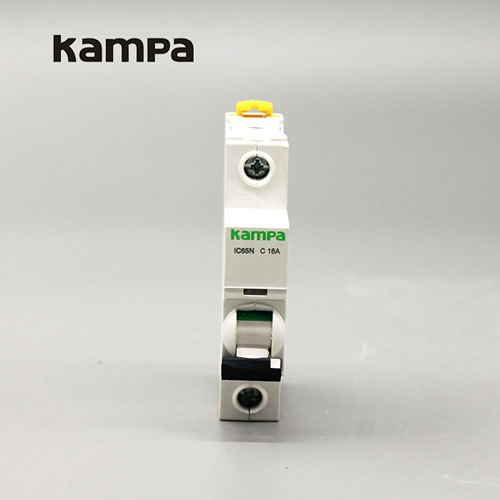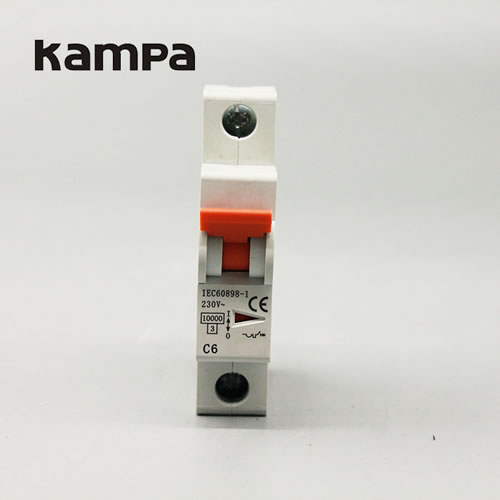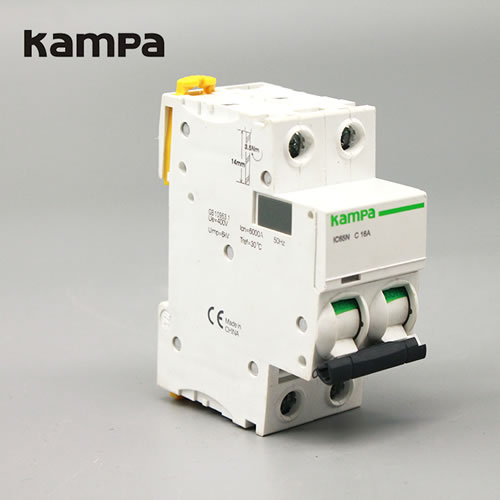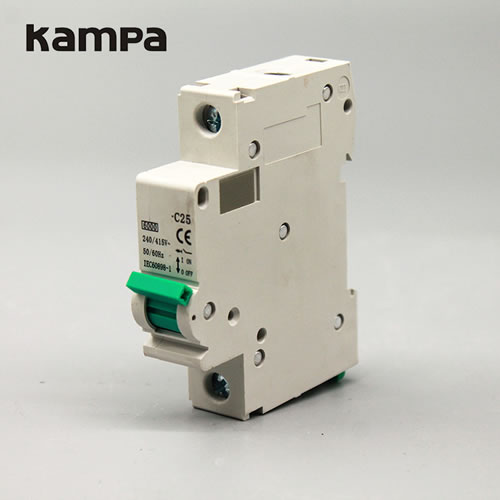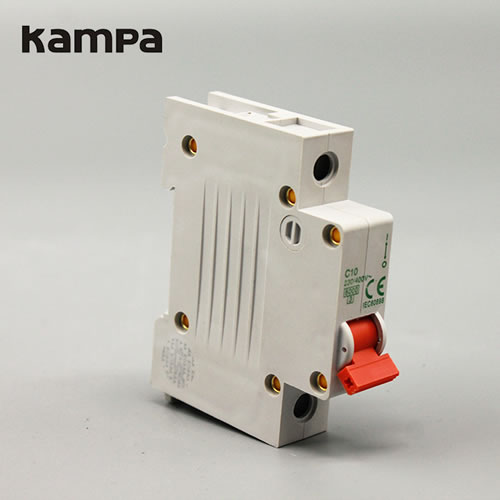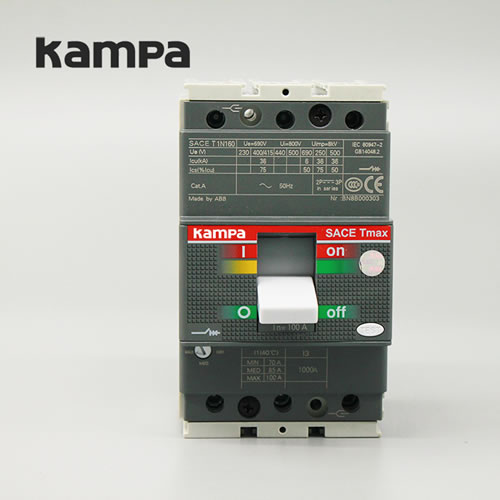Miniature Circuit Breakers (MCB)
Datetime: 4/4/2023 1:59:00 PM Visit: 2212
When the post-80s and post-90s have become the leading force in the new consumption era, our imagination of modern home furnishing has undergone brand-new changes in both depth and breadth. The ideal home should be smarter, more efficient, and more convenient than in the past. Various new electrical appliances should replace our hands to work and assist our brains to issue instructions. MCB manufacturer tells you,Behind all these dream lives, the maintenance of electric energy is inseparable, which increases the risk of circuit overload, short circuits, and leakage. At this time, it is even more necessary for us to understand the circuit breaker, the first protector of safe electricity use, and how to solve the problem quickly and intensively when the risk of electricity use comes.
Table of Contents
- How to choose a miniature circuit breaker
- Precautions when operating circuit breakers
- The difference between various circuit breakers
- Circuit breaker working conditions
- Circuit Breaker Application Scenarios
- What is a circuit breaker (circuit breaker)
- The difference between molded case circuit breaker and miniature circuit breaker
- What is the difference between a miniature circuit breaker and a small circuit breaker?
- The difference between smart miniature circuit breakers and traditional circuit breakers
- Miniature Circuit Breakers (MCB) tell the difference between overcurrent, overload, and short circuit
The miniature circuit breaker is a common electrical protection device, mainly used to protect the circuit from overload and short circuit damage. When selecting a miniature circuit breaker, it is necessary to choose according to the characteristics and requirements of the circuit.
① How to choose a miniature circuit breaker?
1. Electrical parameters
MCB supplier tells you, When choosing a miniature circuit breaker, the first thing to pay attention to is the electrical parameters, mainly including rated voltage, rated current: operating time, etc. The rated word refers to the highest voltage that the miniature circuit breaker can withstand: the rated current refers to the maximum current that the miniature circuit breaker can bear, and the operating time refers to how long the miniature circuit breaker can cut off the circuit when a fault occurs.
Usually, the rated voltage is higher than the actual voltage of the circuit, which is to ensure that the miniature circuit breaker can work normally when the circuit voltage fluctuates. The rated current should be equal to or slightly higher than the maximum load current of the circuit to ensure the safety and reliability of the circuit.
The operating time needs to be determined according to the requirements of the circuit for fault response. For example, in the circuit to protect personal safety, it is necessary to select a miniature circuit breaker with a short operating time to shorten the offline time of the circuit fault as much as possible.
2. The number of poles and the number of plugging and unplugging
The number of poles of miniature circuit breakers is usually 1P, 2P, 3P, 4P, etc., where P means the number of poles. Different numbers of poles are suitable for circuits with different specifications and need to be selected according to the actual situation. In addition, it is necessary to pay attention to the number of plugging and unplugging of miniature circuit breakers. On some special occasions, it is necessary to toggle the miniature circuit breaker frequently, so it is necessary to choose a product with a high number of plugging and unplugging. --Generally speaking, high-quality miniature circuit breakers have a high number of plugging and unplugging.
3. Fault type
MCB Wholesaler Tips, In addition to the protective function of the miniature circuit breaker when the circuit is overloaded and short-circuited, it is also necessary to select different miniature circuit breakers under different fault types.
For example, in lightning protection circuits, it is necessary to use miniature circuit breakers with high lightning surge resistance. In the case of high humidity, it is necessary to choose a miniature circuit breaker with a high humidity protection level. In a high-temperature environment, it is necessary to select a miniature circuit breaker that meets the high-temperature requirements. Different products need to be selected according to the actual application.
4. Brand and quality
Brand and quality are also factors to consider when choosing a miniature circuit breaker. Choosing miniature circuit breakers of well-known brands can guarantee the quality and stability of products. At the same time, for some special occasions, it is necessary to choose products that meet international and domestic standards.
② Precautions when operating circuit breakers
(1) When performing the opening and closing operation of the circuit breaker, no matter what mechanism is used, it should be quickly and decisively, and the operating handle should be quickly pulled to the endpoint until the circuit breaker is indicated to be closed or
The operation is not completed until the sign indicating that the gate is well opened is on.
After the circuit breaker is opened, if the two isolating switches are still to be opened, to prevent accidents caused by pulling the isolating switch with the load when someone mistakenly closes the circuit breaker during operation, the operating
Before the operation, the warning sign "Do not close!" should be hung on the operating handle of the circuit breaker, and then go to the place where the circuit breaker is installed to check the opening and closing indicators and other indicators that can indicate that the circuit breaker is closed.
For parts in the open and stage gate state, the isolating switch can only be operated after confirming that the circuit breaker has been disconnected.
(2) After the circuit breaker is opened, if it is necessary to stop the circuit breaker for maintenance, or to work on the relevant secondary line and relay protection automatic device circuit, the operation of the circuit breaker
disconnect.
(3) The closing speed of the electrically operated circuit breaker is related to whether the voltage of the operating power supply is normal. When the voltage is reduced, due to the insufficient power of the gate, the speed of the gate will be reduced.
Now, at this time prone to circuit breaker explosion accidents. Therefore, the DC operating voltage should be checked before operation.
(4) Before the circuit breaker closes and transmits power, the relevant relay protection and automatic devices that control the circuit breaker should be checked and placed in the operating position, to prevent accidents after closing.
Correct action will remove the fault.
(5) When closing, the operator should pay attention to monitoring the indications of the relevant meters, especially the ammeter, and voltmeter. If an accident symbol is found, it must be cut off immediately. Gate
Finally, check whether the current and voltage of each phase are balanced, to find abnormal phenomena in time and deal with them.
③ The difference between various circuit breakers:
(1) The rated current of the universal circuit breaker is the largest, and it is used for the primary power distribution from the low-voltage end of the transformer. Its frame grades are 1600, 2000, 3200, 4000, and 6300, and the rated current range is 200A-6300A.
(2) The rated current of the molded case is second, and it is often used in secondary power distribution, such as the floor main switch, power box, etc. The frame grades are 125, 160, 250, 400, and 800, and the rated current range is 800A.
(3) The miniature circuit breaker is used at the end of the power distribution circuit, the maximum frame level is 125A, and the rated current of 16-63 is more common.
④ Circuit breaker working conditions:
Ambient air temperature: The upper limit of the ambient air temperature is +40°C; ○The lower limit of the ambient air temperature is -5°C; the average value of the ambient air temperature for 24 hours does not exceed +35°C.
Altitude: The altitude of the installation site shall not exceed 2000m.
Atmospheric conditions: The relative humidity of the atmosphere does not exceed 50% when the ambient air temperature is +40°C; there can be a relatively high relative humidity at a lower temperature; the monthly average maximum relative humidity of the wettest month is 90%. The monthly average minimum temperature is +25°C, and the condensation on the surface of the product due to temperature changes is taken into account.
Pollution level: The pollution level is level 3.
⑤ Circuit Breaker Application Scenarios
1. Nine small places, shopping malls, supermarkets, and other shopping places
3. Nursing homes, welfare homes, orphanages, and other social welfare institutions, libraries, museums, science and technology museums, cultural centers, and other cultural activity centers
4. Stations, rail transit and other transportation hubs, flammable and explosive warehouses, wood processing, textile, spraying, pharmaceutical, and other enterprises
5. Bars, Internet cafes and other entertainment places, kindergartens, primary schools, universities, and other school places
6. Operators and iron tower base stations, road lighting, park lighting, tunnel lighting, metallurgy, chemical industry, textile, and other industrial motors and power systems
7. Hospitals, banks, hotels, and other crowded places
⑥ What is a circuit breaker (circuit breaker)
The circuit breaker is a general term for all the above nouns. A circuit breaker is a mechanical switch that can switch on, carry and break current in a circuit. Note that there are two biggest features of the circuit breaker, one is that it can cut off the current, and the other is that it is equipped with an internal arc extinguishing device. Some switches, such as knife switches, can cut off the current, but they do not have an arc extinguishing device, so they cannot be called circuit breakers.
There are many classification bases for circuit breakers, among which the most mentioned is the classification based on insulation medium and current. According to the insulating medium, it can be divided into air circuit breakers and vacuum circuit breakers; according to the current, it can be divided into miniature circuit breakers, molded case circuit breakers, and frame (universal) circuit breakers.
⑦ The difference between molded case circuit breaker and miniature circuit breaker
Let me talk about the basic similarities first, because both belong to circuit breakers, and both need to comply with some basic product standards and have the same working principle. Then talk about the difference between the two, in general, there are the following points:
1. Different electrical parameters
2. Different mechanical parameters
3. The working environment is different
In addition, from the point of view of purchase, let's talk about the differences between the two.
current level
MCB Wholesaler Tips, Molded case circuit breakers have a maximum current rating of 2000A, while the maximum current rating of miniature circuit breakers is within 125A. Due to the difference in capacity between the two, in specific work, the effective area of the molded case circuit breaker is also larger than that of the miniature circuit breaker, and the connected wires are relatively thick, which can reach more than 35 square meters, while the miniature circuit breaker is only suitable for connecting 10 square meters. wire below the square. Therefore, generally for indoor conditions, it is more suitable to choose a molded case circuit breaker for a larger room.
installation method
Molded case circuit breakers are mainly screw-mounted, easy to compress, have good contact, and have the stable operation. The miniature circuit breaker is mainly installed through the guide rail, and sometimes the contact is poor due to insufficient torque. Due to the different installation methods of the two, the installation of the molded case circuit breaker is more stable and less difficult than that of the miniature circuit breaker.
Operation and life
Operationally. The molded case circuit breaker adopts two sets of devices for protection against overcurrent and short circuits respectively, and the action value of overcurrent protection can be adjusted manually, which is convenient and quick. However, the miniature circuit breaker shares a set of devices for overcurrent and short circuits, and the current cannot be adjusted, which makes it impossible to solve the problem in many cases. The molded case circuit breaker has a large distance between phases and has an arc extinguishing cover, which has a strong arc extinguishing ability, can withstand a larger short-circuit current, and is not easy to cause a short circuit between phases, so the service life is also longer than that of the miniature circuit breaker.
Flexibility of use
Do you know the difference between molded case circuit breakers and miniature circuit breakers - the second picture
In this regard, the molded case circuit breaker is more prominent, and its flexibility in the setting is better than that of the miniature circuit breaker. The overcurrent and short circuit protection devices of the molded case circuit breaker are independent, and the action value of the overcurrent protection during use can also be adjusted flexibly. The over-current protection and short-circuit protection of the miniature circuit breaker are unified devices, and there are certain deficiencies in the adjustment flexibility.
According to the above situation, it seems that the miniature circuit breaker is at a disadvantage, but, for some time, it is still necessary to choose the miniature circuit breaker. For example, when it is necessary to improve the safety of the line because the miniature circuit breaker has high sensitivity and quick breaking action, it is more conducive to the protection of lines and electrical appliances.
⑧ What is the difference between a miniature circuit breaker and a small circuit breaker?
1. Molded case circuit breakers can be connected to thicker wires, such as more than 35 square meters. Miniature circuit breakers are only suitable for connecting wires less than 10 square meters.
2. The ends of the molded case circuit breaker are connected with nuts, which are easy to compress and have good contact. Miniature circuit breakers use smaller compression terminals, which can only be tightened with a screwdriver. The torque is not enough, it is not easy to compress, and the contact is not very good.
3. The molded case circuit breaker adopts two sets of devices for protection against overcurrent and short circuits respectively, and the action value of overcurrent protection can be adjusted manually. Miniature circuit breakers share a set of devices for overcurrent and short circuits, and the current cannot be adjusted.
4. The molded case circuit breaker has a large distance between phases and has an arc extinguishing cover, which has strong arc extinguishing ability, can withstand greater short-circuit current, and is not easy to cause a phase-to-phase short circuit. Life is also long.
5. The action sensitivity of miniature circuit breakers is higher than that of molded case circuit breakers.
⑨ The difference between smart miniature circuit breakers and traditional circuit breakers
The safety intelligent circuit breaker can monitor current, voltage, temperature, power, power factor, and electricity in real-time, and alarm or trip in case of overvoltage, Undervoltage, overload, overcurrent, overtemperature, ignition, short circuit, etc., to prevent electrical fires. Secondly, the leakage protection function of traditional circuit breakers requires people to manually check once a month to ensure that it protects the safety of electricity consumption. The intelligent circuit breaker has the function of automatic leakage protection and self-inspection, avoiding human forgetting, and cutting off in time before electricity accidents occur, which truly protects the safety of people and property.
2. Wisdom Traditional circuit breakers do not have intelligent functions, and it is impossible to achieve remote operation and processing. The smart circuit breaker can be used in conjunction with the smart gateway. Through the mobile APP, it can easily link home air conditioners, fresh air, water and electricity, and smart door locks to realize intelligent control of equipment, energy control, and intelligent switching of home scenes, ensuring users While using electricity safely, it meets the needs of users for smart homes.
3. Energy saving The power consumption of different electrical appliances is different, and the traditional circuit breaker does not have the function of solving the proposed environmental protection, energy saving, and safe use of electricity. Starting with intelligent power distribution, intelligent circuit breakers can make "electricity" in the home safe, energy-saving, and controllable. Real-time monitoring of back-end electrical equipment, recommending limited current through AI algorithm, free setting of circuit on-off time, and energy saving while ensuring safety.
4. Easy installation The intelligent circuit breaker is very convenient to install. Based on the installation of ordinary circuit breakers, there are more gateway signal lines, which can be installed by ordinary electricians. No need to add any other equipment, fast and convenient.
⑩ Miniature Circuit Breakers (MCB) tell the difference between overcurrent, overload, and short circuit
A short circuit is an overcurrent phenomenon, which refers to a situation where the current greatly exceeds the normal full-load current of the circuit. Also, as the name implies, when a short circuit occurs, the circuit loses its normal current-carrying path, causing a short around the load and current returning directly to the source. A short circuit is an overcurrent phenomenon, not an overload phenomenon.
Overloading is when equipment is operated beyond its normal full-load rating, or a conductor exceeds its rated amperage, which, if sustained long enough, can result in damage or dangerous overheating. An overload is not a short circuit, ground, or arcing fault.
Overcurrent can be caused by overload, short circuit, arcing, or ground fault. Overcurrent can cause fire, damage to conductor insulation, and equipment damage.


